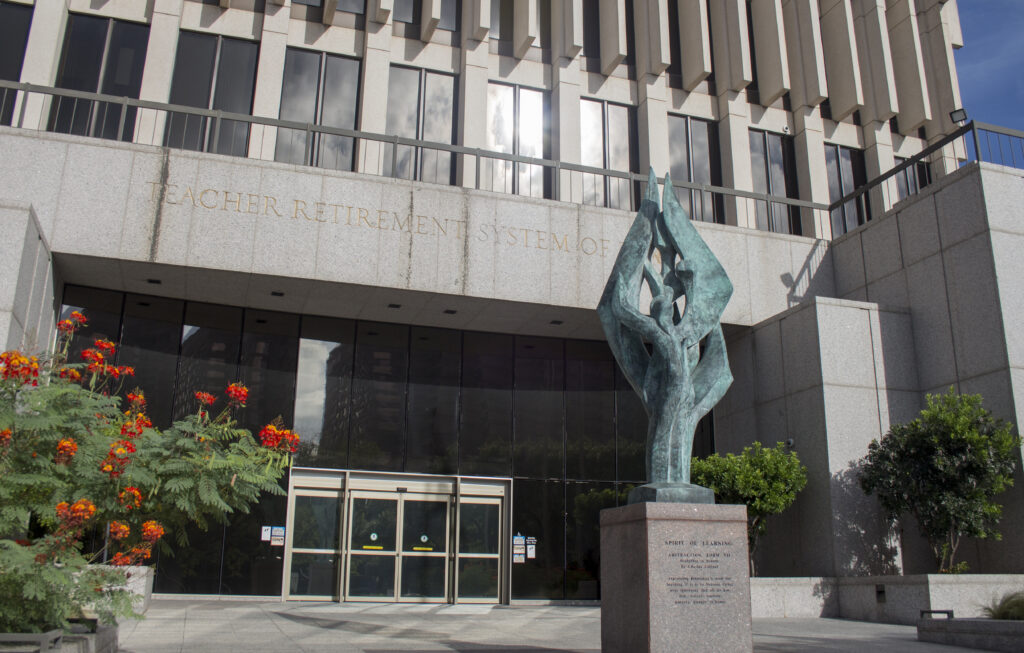As members of the Texas Retired Teachers Association (TRTA) may have read recently in an Inside Line article, the Teacher Retirement System of Texas (TRS) Board of Trustees is considering changing the rate of return assumption for the pension fund that provides retirement income for Texas public education retirees. TRTA has heard from many members who are concerned about how this decision may impact not only the fund, but their monthly annuities as well.
Many retirees have been asking the same question, “If TRS lowers their rate of return assumption, will retirees see a reduction in their pension benefits?” NO, current retirees will NOT see a reduction in their pension benefits if TRS makes a change to the rate of return assumption.
However, a change to the rate of return assumption is still a very big deal, and the proposal to lower the rate of return assumption may have a broad impact on every single TRS annuitant, retired and active.
What that impact may be has everything to do with how the Texas Legislature will respond if TRS lowers the pension fund’s assumed rate of return (how much return TRS expects to earn on its investments).
Why should retirees be concerned about this issue?
Retirees should be concerned that any change to the TRS rate of return assumption may mean that the pension fund will not be actuarially sound, or that the time for the system to be actuarially sound is so much further in the future that it becomes problematic. As retirees know all too well, if the fund is not actuarially sound, it cannot provide benefit increases (COLAs) for retirees.
While this does not represent a cut in your current TRS benefit, it means that benefit increases will be far less likely than if the system were on stronger financial footing. If you retired on or after September 1, 2004, you did not receive the cost-of-living increase passed through Senate Bill 1458 in 2013. More than 150,000 TRS retirees have never received an increase in their monthly annuity!
TRTA supports public policy that provides reasonable benefit enhancements for TRS retirees. If changes are made to the TRS rate of return assumption and more money is not provided to keep TRS financially strong, the ability to provide benefit increases is reduced drastically.
How might this impact active educators and future education employees?
Active educators have much to lose if this rate of return discussion is not followed up by legislative action to ensure the pension fund’s solvency. Some elected officials are anxious to transition new teachers to a defined contribution (DC) or 401k-style retirement plan. TRTA sees this as dangerous public policy.
Transitioning new hires to a DC plan may completely destabilize the TRS pension for current retirees as well as vested actives. Why? TRS would have to change their investment strategy from a plan that is in the “forever business” to that of a closed plan that has no new active member contributions to support the system or to amortize the current unfunded liabilities.
In a state where 95 percent of school employees do not participate in Social Security, not having a defined benefit retirement plan for our educator workforce may leave them without any financial security in retirement.
Think of it like this: would you want to work in a profession where you earned no Social Security benefits, knowing your retirement security was based solely on your teacher salary and upon your ability to make the right financial investment decisions at the lowest possible cost? Consider a worst-case, but somewhat common scenario: no financial security in retirement and being diagnosed with a debilitating disease or medical condition.
It is unreasonable to expect our educator workforce to put their retirement security at risk with no expectation of a guaranteed retirement benefit after serving the state and our schools! The rate of return discussion is a serious one and we all need to pay attention.
Why is this happening now?
The TRS Board of Trustees is the governing body of the Teacher Retirement System of Texas. The Board has nine members. Five of the members are financial and investment experts and four of the members are a mix of active and retired educators. The primary duty of these board members is to act as a fiduciary for the members of the trust—the active and retired school employees. Much of their work is focused on investing the pension trust fund assets to ensure high returns with reasonable costs. The TRS staff and outside experts that advise them on these responsibilities.
Every three to five years, these trustees analyze their investment strategies as well as many other factors through an Actuarial Experience Study. This study guides the actions of the trustees and influences TRS policy.
It is the responsibility of the TRS Board of Trustees to make wise fiduciary decisions regarding the pension fund. These discussions occur in public for all to hear.
Based on numerous factors, outside actuaries and experts have determined that the most fiscally responsible action for TRS to take is to lower its rate of return assumption. This decision must be based on factors such as the state of the stock market and the estimated future performance of the pension fund. For these reasons, TRTA expects the TRS Board of Trustees to lower the rate of return assumption on the TRS investment portfolio.
If you care about your pension fund, learn the formula C+I=B
A simple formula explains how this issue will develop: Contributions + Investments = Benefits. If TRS believes their investment income will be less, contributions to the pension plan will need to increase for benefits to remain completely intact.
If investment income goes down and contributions remain the same (or are reduced), benefits will not be equal to what they are today. These benefit reductions will impact what future retirees may receive in their pension. Drastic changes to investment income may have major consequences on benefits if contributions to the TRS fund remain unchanged or reduced.
TRTA’s concern about changing the rate of return assumption has less to do with the decision to lower the rate of return and more to do with making up the difference in losses by compensating with comparable increases in contributions from the Texas Legislature.
TRTA’s position is that TRS should ask the Legislature to make up the loss of earnings with higher contributions as part of the permanent base funding for the pension fund.
If the TRS Board adopts all of the actuary’s recommendations, including lowing the investment return assumption to 7.25 percent, then the state’s contribution would have to be increased from 6.8 percent to 8.6 percent immediately in 2018 to keep the funding period at 30 years (a statutory requirement to make the fund actuarially sound). In dollars, that cost would equal approximately $1.6 billion to the state. If TRS lowered the return assumption to only 7.5 percent, the required increase would need to be 1.4 percent instead of 1.8 percent, meaning the state contribution would need to increase to 8.2 percent. The cost for the 1.4 percent increase for the biennium would be $770 million to the state.
Those percentages may need to be altered, since no changes in contributions to the fund can be made until the Legislature is in session in 2019.
Regardless of the rate of return assumption decision made by the TRS Board of Trustees, TRTA feels that when TRS submits its legislative appropriations request to the Legislative Budget Board, TRS should ask the state to increase its contribution to the fund in a comparable manner to ensure the fund’s actuarial soundness.
TRTA also recommends that TRS request that this increase be permanent, not exceptional or supplemental. The Legislature must develop a long-term plan for funding TRS.
A long-term plan is the best way to ensure all current and future annuitants are protected. TRS can’t come back each legislative session requesting supplemental funding to fill in the gaps left by investment earnings losses.
Which rate of return assumption is most beneficial to retirees?
The 7.25 percent rate includes lowering the inflation rate from 2.5 percent to 2.3 percent. Given the current environment and the federal government raising rates, it may be prudent not to lower the inflation rate.
The estimated market returns are based on average returns for all assets classes. TRS has an excellent investment team that adds value above index returns. Clearly the expectation and TRS’s track record show that the professional staff should be able to add at least 25 basis points to performance. Additionally, the Employees Retirement System of Texas (ERS) adopted a 7.5 percent return assumption, and it seems reasonable that TRS would be equal to or higher than ERS in investment performance.
The TRS actuary has also indicated that a 7.5 percent return assumption for TRS is not unreasonable. It may be better for TRS to make a less drastic change now and re-evaluate the fund’s performance during the next experience study conducted in another three to five years.
When is all this happening?
The TRS Board of Trustees is expected to make a decision regarding lowering the rate of return assumption at their next board meeting on April 19 and 20, 2018. This meeting will be held in Austin, Texas and will be viewable live online via webcast. TRTA will provide more information about how you can attend in person or view this meeting as it becomes available.
Where does TRTA stand on this issue?
Our Texas TRS pension plan is well-managed, supported by public education employees, recognized as a major benefit to recruiting employees, has been a funding priority of the state for decades, and is a great Texas success story. More than 1.3 million Texans participate in the TRS pension plan. Texas educators, retirees, and elected officials have worked together for more than seven decades managing, protecting, and improving this pension system.
Texas public education retirees rely on the pension fund as their sole form of financial security in retirement. In order to plan for their futures, retirees need to know that their pension fund will be there and that they will not face the possibility of reduced monthly annuities or benefit cuts.
TRS is at a critical stage in its history. Reducing the rate of return assumption to better reflect current market conditions is the fiscally responsible thing to do. However, these changes can’t come at the cost of retirees’ benefits. Additionally, reduced benefits jeopardize the potential for a future educator workforce.
A decision to lower the TRS investment rate or return assumption without a corresponding legislative increase in contributions to the fund will result in reduced benefits for TRS members.
While predicting what benefits may be impacted is difficult, it is possible to speculate that those changes could include retirement benefit reductions, extending years of service, minimum retirement age being increased, or other changes. It is very possible that making the wrong decisions in the legislative process could lead to future retirees having reduced annuity amounts from what they anticipate receiving currently.
Although it is unlikely that current retiree annuities would be impacted, any decision made by the Legislature that does not protect the fund from drastic changes in projected revenue could mean no benefit increases for retirees will even be considered for years to come.
What do I need to know right now and how can I help?
TRTA believes:
- that TRS has a fiduciary duty to act;
- that reducing the TRS rate of return from 8 percent to 7.25 percent is too drastic;
- that if a reduction is necessary, TRTA suggests a more reasonable change from 8 percent to 7.5 percent;
- that any change to the rate of return assumption should be met with an increase in state funding to the pension system;
- that TRS has a further fiduciary duty to adequately, appropriately, and directly inform the Legislature that they must increase contributions to make up for the lost investment income.
The message is this: Keep the TRS pension plan actuarially sound with a balanced funding policy. If investment income is reduced, contribution income must be increased! Retired and active school employees earn their pension and deserve a stable retirement.
Many Texas officials believe in TRS, appreciate educators and support retirees. TRTA and the Texas Legislature have worked together for decades. We MUST continue to find ways to protect TRS benefits.
Let’s start by letting our elected officials know we appreciate their attention to TRS issues. If officials and TRS annuitants recognize the value of TRS and know that our pension fund is worth protecting and improving, we can tackle this issue.
TRTA members, we have a full legislative agenda with many different issues such as the TRS pension fund, improving TRS-Care, funding benefit increases for retirees and reforming federal Social Security policies. TRTA members are the strongest advocates in the nation! We can and will make a difference on the important issues.
Next week, TRTA will launch an online advocacy and education campaign. Stay tuned as we continue to make a difference on this important topic together.




